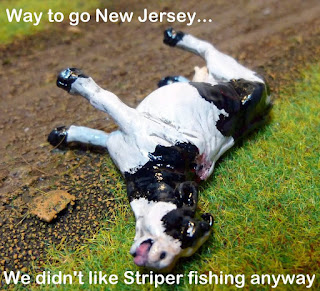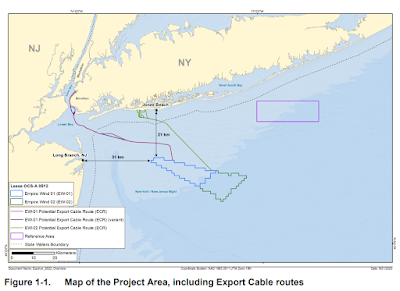This blog was written back on February 22, 2013. at the time, the ASMFC had declared that the stocks were healthy and robust and that the 2011 year class was the best spawn year on record and things are wonderful. We have now arrived in 2019.
Note that as of February 2019 the Striped Bass stocks have been declared OVERFISHED and OVERFISHING is occurring.
This means that adult bass are being removed faster than the stock can replenish itself.
When I started serious striper fishing back in the early 80’s it took me three years to catch my first bass. No, wise guy, it wasn’t because I was a bad fisherman, it was because there were NONE to catch. As hard as it is to imagine now, we (humans) had overfished and depleted the stock down to almost nothing.
One of my fondest fishing memories took place one early morning on the Navesink River. I saw the first silver flash behind my blue/chrome bomber plug. After thousands of casts, this little sign of life was all I needed. The years that followed that single flash were nothing short of spectacular, and as time went on it became “normal” for me to catch release and sometimes tag 15-25 bass on a given day.
Nowadays, striped bass fishing along the Jersey shore during May & June has become nothing short of spectacular over the past decade or so. All those shorty bass have grown up in a big way. Acres and acres of foot long adult Atlantic Menhaden (Bunker) take up along our shoreline and oodles of big fat stripers stick like glue to these oil-rich, protein-packed morsels. Many of these bass are well over Jersey’s 28” limit and at times, they are stacked up like cordwood and eager to eat. You don’t need to be a detective to see where this conversation is headed. Many striper sharpies that lived thru the last downfall will tell you (regardless of the current ASMFC stock assessment numbers) that we are already seeing signs of another downturn.
Personally, I feel that if we continue at the current pace, with hundreds of anglers practicing catch kill and fillet with during the spring session we are playing with fire. As if this wasn't bad enough, our bass dont have enough food to eat. We have the depletion of forage species throughout the migration range with record low levels of river herring, menhaden, and American eel and then add a heaping dose of Mycobacteriosis. A blind man can clearly see that we are on the road to yet another crash/moratorium. We are just not seeing the numbers of juvenile bass that we used to see. You don't have to be a marine biologist to figure out that the striped bass biomass is off balance and leaning in the wrong direction. It really is up to us anglers to be stewards of our waters and to take individual action instead of waiting for some stock assessment to tell us that we are overfished.
As a fishing guide that is paid to put clients on fish and help them to hook and land a fish of a lifetime, I feel compelled to share my own views on this unique fishery and the issues that come with it. Some of the larger breeder bass that gather here, post spawn represent the brood stock from virtually all of our major production areas. We have Hudson, Raritan, Delaware, Roanoke River bass and of course, Chesapeake bay strains. We are talking about cow bass that are 30, 40, 50 and yes, although rare, 60 pounds and over!
After learning the right techniques, even a first time out novice can slam some enormous bass and potentially, catch the big bass of a lifetime. In NJ, our regulations allow you to take home two bass per day over 28” size and if you spring for the $2.00 special “trophy” tag, you can bring an additional one home per day at 28” or longer.
The local tactic of choice is to “liveline” a bunker. In the simplest of terms, livelining is the art of sticking a hook in a live bunker and letting it swim away from you and get eaten. Needless to say, this type of fishing is very exciting and its a heck of a lot of fun to watch your bunker get engulfed by a giant bass. With the fortunate abundance of these adult bunker along the jersey shore, even surf anglers with far casting braided line, can get into the fun by heaving a snag hook into a bunker school and do something called “snag & drop”. Kayak anglers are having even more of a blast getting towed around by these cows as well.
As much as I love to talk about catching fish, that’s not what this blog is about. It’s about the dilemma that occurs once these cows land in the anglers hands. There's no doubt that this fishery is as exciting and productive as it sounds but it brings with it some ethical challenges. This conversation comes up all the time on board my boat, “Reel Therapy”. Although many of my clients are catch and release people, many of them really enjoy eating bass and choose to take fish home with them. I feel that as sportsmen if we are going to take a fish home to eat, it's up to us to decide on the size of the fish to kill and eat.
Conservation aside, striped bass are delicious and my family really enjoys them. However, the thought of feeding my family a 20 plus-year-old bass is just plain nasty to me. On board my boat I release a lot of bass, but when I do keep a fish I have implemented my own personal slot limit and encourage others to do the same. I have set this on one bass between 28-34 inches that I will eat fresh that night. I’m not big on freezing fish and it crushes me to discover a frozen fillet in the back of my freezer a year later.
As far as I am concerned, the days of standing on your driveway or in front of bait shop scale with a stiff 40 pounder are over. The glory is clearly on the water. Next time you land a cow, quickly hoist her up, have a buddy snap a picture or two, and then lower the fish back in the water. I promise you a feeling second to none as she revives, pulls out of your hand and swims away. Best of all, there’s a good chance that the same bass you release today will be dropping a zillion eggs next spring at spawning time and keeping the future of this wonderful fishery alive.




Comments
Post a Comment